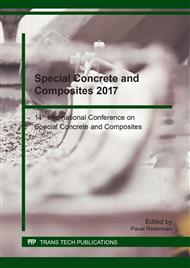[1]
R. Šulc, P. Svoboda, Activation of fly ash binder in POP concrete without heating, in: XI. Conf. Ekologie a nové stavební hmoty a výrobky, VUSTAH, Telč, 2007, pp.116-119.
Google Scholar
[2]
T. Váchal, P. Svoboda, Influence of temperature and time of heat curing in geopolymer reactions of fly-ash concrete mixtures, in: XVI. Conf. Ekologie a nové stavební hmoty a výrobky, VUSTAH, Telč, 2012, pp.79-82.
Google Scholar
[3]
J. Poláček, R. Šulc, Properties of Materials from activated fly ash from fluidized burning, in: 11th International Conference Special Concrete and Composites 2014, Skalský Dvůr, 2014, p.173 – 177.
DOI: 10.4028/www.scientific.net/amr.1000.338
Google Scholar
[4]
J. Poláček, R. Šulc, Characteristic properties of the fly ash from coal combustion, in: Special Concrete and Composites 2015, Skalský Dvůr, 2015, pp.75-79.
Google Scholar
[5]
M. Vašák, The diploma thesis, CTU in Prague, Faculty of Civil Engineering, Praha (2016).
Google Scholar
[6]
T. Váchal et al., Chemical Properties and Reactivity of CFBC Fly Ash, Key Engineering Materials, Vol. 722, pp.132-139, (2016).
DOI: 10.4028/www.scientific.net/kem.722.132
Google Scholar
[7]
J. Temuujin, R.P. Williams, A. van Riessen, Effect of mechanical activation of fly ash on the properties of geopolymer cured at ambient temperature, Journal of Materials Processing Technology, Volume 209, Issue 12, 2009, Pages 5276-5280, ISSN 0924-0136.
DOI: 10.1016/j.jmatprotec.2009.03.016
Google Scholar
[8]
A.A. Zaldívar-Cadena et al., Effect of Milling Time on Mechanical Properties of Fly Ash Incorporated Cement Mortars, Advanced Materials Research, Vol. 787, pp.286-290, (2013).
DOI: 10.4028/www.scientific.net/amr.787.286
Google Scholar
[9]
K. J. Laidler, The World of Physical Chemistry, in: Oxford University Press, ISBN 0-19-855919-4.
Google Scholar
[10]
CSN 72 2080 Fluid fly ash for building purposes.
Google Scholar
[11]
A. G. Whittaker, A. R. Mount, and M. R. Heal, Physical Chemistry, Instant Notes Series, BIOS Scientific Publishers, Oxford, UK, (2000).
DOI: 10.4324/9780203009925
Google Scholar
[12]
Fraay, A.L.A., Bijen, J.M. and De Haan, Y.M. The reaction of fly ash in concrete, a critical examination, Cement and Concrete Res., vol. 19, 1989, pp.235-246.
DOI: 10.1016/0008-8846(89)90088-4
Google Scholar
[13]
Xu, A. and Sarkar, S.L. Microstructural development in high-volume fly-ash cement system, J. of Mat. in Civil Eng., vol. 6, 1994, pp.117-136.
DOI: 10.1061/(asce)0899-1561(1994)6:1(117)
Google Scholar
[14]
Taylor, H.F.W. Cement chemistry, 2nd ed. London: Thomas Telford, (1997).
Google Scholar
[15]
Hewlett, P.C. Lea's chemistry of cement and concrete, 4th ed. London: Arnold, (1998).
Google Scholar
[16]
Song, S. and Jennings, H.M. Pore solution chemistry of alkali-activated ground granulated blastfurnace slag, Cement and Concrete Res., vol. 29, 1999, pp.159-170.
DOI: 10.1016/s0008-8846(98)00212-9
Google Scholar
[17]
Song, S., Sohn, D., Jennings, H.M. and Mason, T.O. Hydration of alkali-activated ground granulated blast furnace slag, J. of Mat. Sci., vol. 35, 2000, pp.249-257.
Google Scholar
[18]
Pietersen, H.S. Reactivity of fly ash and slag in cement, Ph.D. Thesis, Delft University of Technology, The Netherlands, (1993).
Google Scholar
[19]
ČSN EN 450-1, Popílek do betonu: Definice, specifikace a kritéria shody, (2013).
Google Scholar
[20]
Rentgenová prvková analýza XRF, VŠCHT (online), Praha 2015, Accesible from: http: /old. vscht. cz/clab/RTG.
Google Scholar


